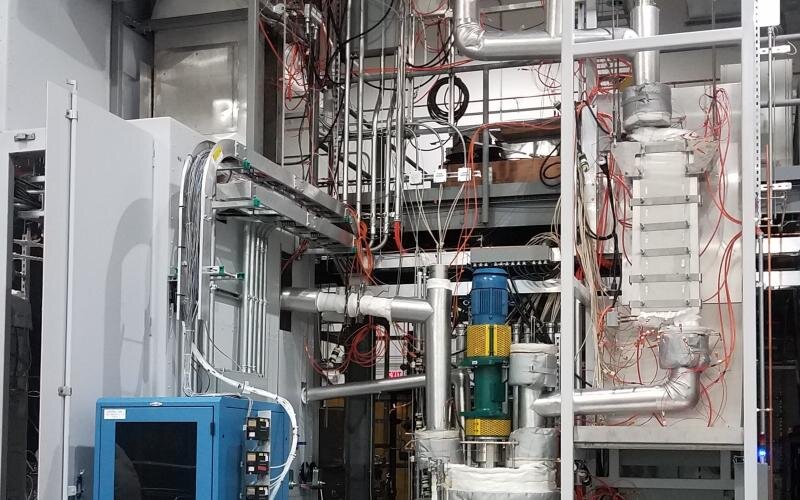America’s largest open-science chloride salt loop will accelerate clean energy technologies
Scientists at the U.S. Department of Energy’s Oak Ridge National Laboratory have begun operating a unique system designed to enable a variety of testing to characterize the performance of an advanced heat transfer fluid for renewable energy.
Known as the Facility to Alleviate Salt Technology Risks, or FASTR, the system’s inaugural run evaluated the viability of using a mixture of magnesium, potassium and sodium chloride-based molten salt technology for solar thermal power.
FASTR is the first loop of its kind in operation, designed to study potentially corrosive chloride salts in a flowing environment. Proof of stable operation and overall performance could increase the efficiency and economic competitiveness of the next generation of concentrating solar power, or Gen3 CSP. Chloride salt is also a uniquely inexpensive heat transfer fluid that could be directly used for thermal energy storage.
Power tower CSP plants collect and store energy using fields of mirrors that concentrate sunlight onto a receiver at the top of a tower, delivering energy to a heat transfer fluid. These power towers have traditionally used steam or nitrate salts to transfer energy and drive power cycles for electricity generation.
ORNL scientists are using FASTR—which officially started flowing operations in December 2022—to study the feasibility of a new approach of molten chloride salts as a high-temperature energy storage and heat-transfer fluid. The facility uses a blend of sodium chloride, potassium chloride and magnesium chloride, a cost-effective mixture with a low melting point and favorable thermophysical properties.
“The salt test loop will enable the research necessary to make this technology a reality,” said Kevin Robb, Energy Systems Development group leader in ORNL’s Nuclear Energy and Fuel Cycle Division. “FASTR’s inauguration caps an almost five-year effort that included designing, building and operating the largest open-science research facility pumping molten chloride salt in the United States, and likely the world,” Robb said.
A path forward
Early in the Gen3 CSP initiative, DOE identified molten chloride salt as a leading opportunity to enable power plant temperatures greater than 1300°F. Researchers looked closely at the corrosion science of chloride salts as well as component design. A key gap existed in proving basic scientific studies could be scaled to a flowing molten salt test system.
To fulfill this need, the Solar Energy Technologies Office within the DOE Office of Energy Efficiency and Renewable Energy sponsored the development of FASTR to serve as an open-science, high-temperature test facility. Knowledged gained from this facility’s operations can ultimately feed into the greater Gen3 CSP liquid pathway integration.
To build FASTR, scientists relied on their experience developing its predecessor, ORNL’s fluoride salt loop, or LSTL, which led to several technological advancements . FASTR is twice the size of LSTL, standing nearly 23 feet tall with 2-inch piping. It also doubles LSTL in power and flow rate. FASTR’s scaled-up purification system can handle 200-kilogram batches of salt at a time. Testing performed in FASTR can reach temperatures higher then LSTL’s maximum temperature of 1,328°.
Researchers have identified several high-impact test campaigns, including corrosion monitoring and control, demonstration of oxygen impurity sensors and performance testing of major components. There are also plans to test new sensors in the flowing salt environment, in collaboration with industry.
“With a successful startup, there will undoubtedly be new insights and lessons learned ahead,” said Robb.
Overall, the FASTR research facility has significantly contributed to DOE EERE’s goal of derisking and advancing concentrated solar power technology, as well as pushing forward the development of chloride-based molten as a next-generation heat transfer fluid.
More information:
Kevin Robb et al, Facility to Alleviate Salt Technology Risks (FASTR): Design Report (2022). DOI: 10.2172/1906574
Citation:
America’s largest open-science chloride salt loop will accelerate clean energy technologies (2023, February 14)
retrieved 14 February 2023
from https://techxplore.com/news/2023-02-america-largest-open-science-chloride-salt.html
This document is subject to copyright. Apart from any fair dealing for the purpose of private study or research, no
part may be reproduced without the written permission. The content is provided for information purposes only.
For all the latest Technology News Click Here
For the latest news and updates, follow us on Google News.

